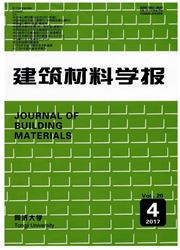

 中文摘要:
中文摘要:
采用自由基聚合法,以丙烯酸、甲氧基聚乙二醇甲基丙烯酸酯和苯乙烯制得亲疏水性不同的高分子.通过调整亲水性和疏水性单体的共聚比例,逐渐改变共聚分子的水溶性.当疏水单体苯乙烯掺量(质量分数)占到总单体的50%及以上时,所合成的共聚分子通过疏水相互作用自组装形成高分子纳米颗粒,由水溶性高分子溶液转变为水分散性高分子乳液.随着共聚单体苯乙烯掺量的增大,自组装纳米粒子的粒径逐渐增大.采用净浆流动度评价了合成的高分子纳米粒子对水泥浆的减水分散作用,发现掺入纳米粒子乳液可显著提高水泥浆体的流动性,并表现出良好的缓释性和流动性保持能力;采用等温微量热仪研究了纳米粒子乳液对水泥水化进程的影响,发现纳米粒子乳液同样表现出延缓水泥水化的效应,但缓凝性远小于常用的聚羧酸减水剂.
 英文摘要:
英文摘要:
Polymeric superplasticizers with varied hydrophobicity were synthesized by eopolymerizing acryl- ic acid, methyl polyethylene glycol methacrylate and styrene through free radical polymerization. The Wa- ter-solubility of the synthesized polymers was adjusted by changing the copolymerization ratio of hydro- philic and hydrophobic monomers. It is found that the synthesized polymers change from water soluble to insoluble and form nano-particle dispersions when the proportion of styrene monomer is above 50%. The particle size of the nano-particle dispersion increases with increase of the styrene proportion. The mini-cone tests were conducted to evaluate the dispersing capability of the polymer nano-particles in cement pastes. It is shown that the prepared polymer nano-particles can effectively enhance the fluidity of fresh cement pastes. The fluidity of fresh cement pastes by addition of nano-particle dispersion shows good retention and even increases with elapsed time, indicating that the nano-particle dispersion bears so called slow-releasing effect in fluidity retention of fresh cement pastes. Isothermal calorimetry was employed to study the effect of polymer nano-particles on cement hydration. It is found that addition of polymer nano-particles in the fresh cement pastes causes retardation effect but to a lesser degree than the widely used polycarboxylate superplasticizers.
 同期刊论文项目
同期刊论文项目
 同项目期刊论文
同项目期刊论文
 Polymer-modified mortar with a gradient polymer distribution: Preparation, permeability, and mechani
Polymer-modified mortar with a gradient polymer distribution: Preparation, permeability, and mechani Study on the rheological properties of Portland cement pastes with polycarboxylate superplasticizers
Study on the rheological properties of Portland cement pastes with polycarboxylate superplasticizers Influences of superplasticizer, polymer latexes and asphalt emulsions on the pore structure and impe
Influences of superplasticizer, polymer latexes and asphalt emulsions on the pore structure and impe Effect of the charge characteristic of the backbone of polycarboxylate superplasticizer on the adsor
Effect of the charge characteristic of the backbone of polycarboxylate superplasticizer on the adsor 期刊信息
期刊信息
